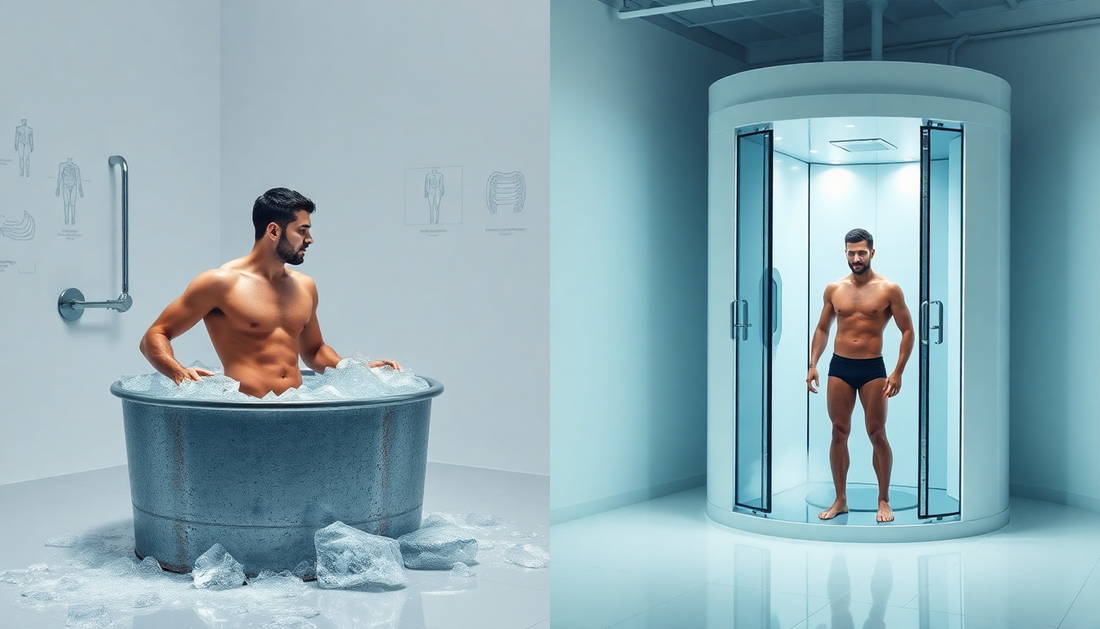
Cold Plunge vs Cryotherapy: Which One's Right for Your Recovery?
Share
The world of wellness and biohacking has seen a surge of interest in cold therapy in recent years. From professional athletes to health-conscious individuals, people are turning to techniques like cold plunges and cryotherapy to enhance recovery, boost performance, and support overall well-being. As the options for cold therapy continue to expand, it can be challenging to determine which approach is the best fit for your needs.
In this blog post, we'll dive deep into the world of cold plunges and cryotherapy, exploring the key differences, benefits, and considerations to help you make an informed decision on the right cold therapy solution for your recovery and wellness journey.
What Is a Cold Plunge?
A cold plunge, also known as cold water immersion or cold hydrotherapy, involves submerging the body in cold water, typically ranging from 50°F to 65°F (10°C to 18°C). This practice has been used for centuries, with roots in ancient cultures and traditions, and has gained significant popularity in recent years as a natural way to support the body's recovery and overall health.
The benefits of a cold plunge are numerous. When the body is exposed to the cold water, it triggers a physiological response that can:
- Reduce inflammation and muscle soreness: The cold temperature helps constrict blood vessels, reducing blood flow and inflammation in the muscles.
- Boost circulation and oxygen delivery: The body's response to the cold water stimulates the circulatory system, improving blood flow and oxygen delivery to the tissues.
- Enhance the immune system: Cold water exposure can activate the sympathetic nervous system, which can help strengthen the immune system.
- Improve mental focus and mood: The cold water can trigger the release of endorphins, leading to improved mood and mental clarity.
Cold plunges are particularly beneficial for athletes, fitness enthusiasts, and individuals who engage in high-intensity or physically demanding activities, as they can aid in the recovery process and help the body bounce back more quickly.
What Is Cryotherapy?
Cryotherapy, on the other hand, is a more advanced form of cold therapy that involves exposing the body to extremely low temperatures, typically ranging from -200°F to -250°F (-129°C to -157°C). This is typically done in a specialized cryotherapy chamber or a whole-body cryotherapy (WBC) unit.
There are two main types of cryotherapy:
- Whole-body cryotherapy (WBC): In this approach, the individual stands in a cryotherapy chamber and is exposed to the extremely cold temperatures for a short period, usually 2-3 minutes.
- Localized cryotherapy: This involves targeting specific areas of the body, such as joints or muscles, with a focused stream of cold air or a cold pack.
The benefits of cryotherapy are similar to those of a cold plunge, but the effects can be more pronounced due to the extreme temperatures. Cryotherapy can:
- Reduce inflammation and pain: The extreme cold helps constrict blood vessels, reducing blood flow and inflammation in the targeted areas.
- Boost metabolism and calorie burn: The body's response to the cold temperatures can increase metabolic rate and calorie expenditure.
- Improve skin health and appearance: Cryotherapy can stimulate collagen production and improve skin tone and texture.
- Enhance mood and cognitive function: The cold exposure can trigger the release of endorphins and improve mental focus and clarity.
Cryotherapy is often used by professional athletes, fitness enthusiasts, and individuals seeking to optimize their recovery, performance, and overall well-being.
Cold Plunge vs. Cryotherapy: Key Differences
While both cold plunges and cryotherapy offer benefits for recovery and wellness, there are some key differences to consider:
| Characteristic | Cold Plunge | Cryotherapy | | --- | --- | --- | | Temperature Range | 50°F to 65°F (10°C to 18°C) | -200°F to -250°F (-129°C to -157°C) | | Duration of Exposure | 10-20 minutes | 2-3 minutes | | Targeted Areas | Whole body | Whole body (WBC) or specific areas (localized) | | Accessibility | More widely available, can be done at home | Requires specialized equipment and facilities | | Cost | Generally more affordable | Can be more expensive, especially for whole-body sessions |
Which One Should You Choose?
When deciding between a cold plunge and cryotherapy, it's important to consider your specific goals, preferences, and accessibility.
If you're looking for a more affordable and accessible option that can be easily incorporated into your daily routine, a cold plunge may be the better choice. The gradual exposure to cold water can provide many of the same benefits as cryotherapy, without the need for specialized equipment.
On the other hand, if you're seeking more intense and targeted cold therapy, cryotherapy may be the better fit. The extreme temperatures of cryotherapy can lead to more pronounced effects, particularly for individuals with specific recovery or performance goals.
Ultimately, the decision between a cold plunge and cryotherapy will depend on your individual needs, budget, and access to the necessary facilities. It's always a good idea to consult with a healthcare professional or a qualified wellness expert to determine the best approach for your specific situation.
At EvoWell, we offer a range of cutting-edge cold therapy solutions, including hyperbaric chambers, red light therapy, and cryotherapy, to help you optimize your recovery, longevity, and performance. Explore our selection of premium wellness and biohacking products and find the right cold therapy solution for your needs.
https://evowell.co.uk/collections/all
